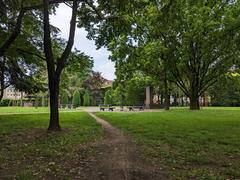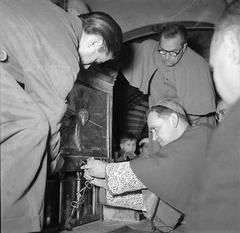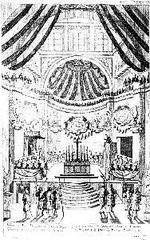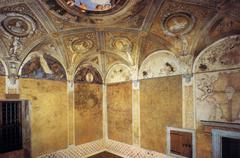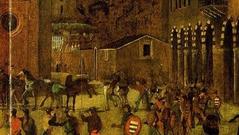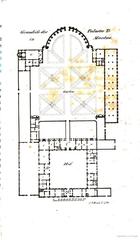Palazzo San Sebastiano, Mantua, Italy: Visiting Hours, Tickets, and Historical Sites Guide
Date: 15/06/2025
Introduction
Palazzo San Sebastiano is a Renaissance masterpiece and one of Mantua’s most significant historical sites, offering a window into the city’s vibrant cultural past. Commissioned by Francesco II Gonzaga in the early 16th century, the palace showcases the interplay of political power, artistic innovation, and refined architectural design that characterized Mantua’s golden age. Today, it houses the MACA Museum (Mantova Collezioni Antiche), where visitors can explore collections spanning antiquity to the Renaissance. This guide provides in-depth information on the palace’s history, artistic heritage, visitor services, and practical advice for a rewarding visit.
Table of Contents
- Introduction to Palazzo San Sebastiano
- Origins and Construction
- The Gonzaga Era and Artistic Patronage
- Decline, Restoration, and Modern Use
- The MACA Museum: Collections and Themes
- Architectural Features and Artistic Highlights
- Visitor Information: Hours, Tickets, and Accessibility
- Getting There and Nearby Attractions
- Visitor Experience and Practical Tips
- Frequently Asked Questions (FAQ)
- Plan Your Visit and Stay Connected
- Sources
Origins and Construction
Commissioned by Francesco II Gonzaga between 1506 and 1512, Palazzo San Sebastiano was conceived as a suburban villa, distinct from the larger Palazzo Ducale. Designed by Girolamo Arcari and Bernardino Ghisolfo, it features harmonious proportions, elegant courtyards, and a seven-arched loggia, exemplifying the transition from late Gothic to early Renaissance architecture. Its original gardens, now lost, were richly adorned with rare plants, citrus trees, and fountains, expressing the Renaissance ideal of integrating nature and architecture (Italia.it, Mantova.com).
The Gonzaga Era and Artistic Patronage
During the Renaissance, Mantua flourished as a center for the arts, largely due to the patronage of the Gonzaga dynasty. Palazzo San Sebastiano functioned as both a private residence and a venue for intellectual and artistic gatherings. Its halls were adorned with frescoes by artists such as Lorenzo Leonbruno, Matteo Costa, and Lorenzo Costa the Elder. The palace’s grand hall was designed to display Andrea Mantegna’s monumental cycle, Triumphs of Caesar, reflecting the Gonzagas’ ambition to emulate the grandeur of ancient Rome. Although the originals are now at Hampton Court, London, seventeenth-century copies are displayed within the palace (Finestre sull’Arte, WhichMuseum).
Decline, Restoration, and Modern Use
After the Gonzaga dynasty’s decline, the palace fell into disrepair and was used for various functions, including as military barracks and a hospital. Restoration efforts in the 20th and 21st centuries, led by the Municipality of Mantua, stabilized the structure, revived the frescoes, and restored its Renaissance character. In 2005, the palace became the Museo della Città, narrating Mantua’s civic history. Since 2023, it has hosted the MACA Museum, spotlighting Mantua’s ancient collections and reinforcing its role as a cultural and educational hub (MACA Official, altramantova.it).
The MACA Museum: Collections and Themes
MACA (Mantova Collezioni Antiche) is a civic museum dedicated to the city’s passion for antiquity. Its collections are organized around four key themes:
- Classical Antiquities: Assembled by Francesco II and Vespasiano Gonzaga, reflecting Renaissance fascination with Greco-Roman art.
- Egyptian Collection (Giuseppe Acerbi): Featuring artifacts acquired by the Mantuan diplomat and explorer.
- Mesopotamian Collection (Ugo Sissa): Rare cuneiform tablets and objects tracing Mantua’s connections to the ancient Near East.
- Civic Collections: Integrating objects from the 19th-century Museo Patrio (maca.museimantova.it).
The museum’s layout is both rational and engaging, guiding visitors through rooms such as the “Porcospino” and “Crogiolo,” which are adorned with emblems and symbols of Gonzaga power and Renaissance virtue (in-lombardia.it).
Architectural Features and Artistic Highlights
- Layout: Rooms are arranged around a central courtyard, with a scenic loggia offering a grand entrance.
- Frescoes: Lavish decorations by leading Renaissance artists, including grotesques inspired by the Domus Aurea.
- Thematic Rooms: Such as the Camera del Porcospino, Camera del Crogiolo, and Sala dei Trionfi, each with unique iconography and purpose.
- Collections: Antiquities, Renaissance busts, sarcophagus fronts, and cycles of frescoes and tapestries (Wikipedia, Finestre sull’Arte).
The palace’s structure and decoration were intended to symbolize not only the might of the Gonzaga dynasty but also the city’s broader cultural ambitions.
Visitor Information: Hours, Tickets, and Accessibility
Opening Hours
- Daylight Saving Time: Monday 13:00–19:30; Tuesday–Sunday 9:00–19:30
- Standard Time: Monday 13:00–18:30; Tuesday–Sunday 9:00–18:30
- Last entry is one hour before closing. Closed on December 25 (centropalazzote.it).
Tickets
- Full price: €15
- Concessions: €11
- Special Concessions: €7 (ages 12–17, students, other eligible groups)
- Free entrance: Children up to 11 years old
- Family ticket: €40 (3–5 persons, max 2 full-price payers)
- Mantova e Sabbioneta Card: €25 (full price), €13 (concessions); grants access to various sites within 72 hours
Tickets can be purchased on-site or online. Group and school visits should be booked in advance (centropalazzote.it).
Accessibility and Facilities
- Wheelchair access: Fully accessible
- Restrooms: On site
- Cloakroom: Ask at the entrance
- Library: Open to the public during set hours
- Audio guides: €5, available in multiple languages; free for visually impaired visitors
- App: Downloadable with interactive maps and itineraries
- Dog-sitting: €10/hour; guide dogs permitted
Getting There and Nearby Attractions
Location
- Address: Largo XXIV Maggio, 12, 46100 Mantua, Italy
Transport
- By train: Local buses (lines 4T, 4S, 4C, 8) from the main station, or free Navetta Te shuttle every 15 minutes from the city center (centropalazzote.it)
- By bike: Dedicated paths connect the city center to the palace
Nearby Sites
- Palazzo Te: Mannerist masterpiece, 5-minute walk
- Basilica di Sant’Andrea: Renaissance church, 18-minute walk
- Clock Tower: Astronomical clock, 18-minute walk
- Rotonda di San Lorenzo: Mantua’s oldest church, 17-minute walk
Visitor Experience and Practical Tips
- Crowds: Generally less crowded than other major sites, offering a peaceful visit (explorial.com)
- Language: Many labels in Italian; use audio guide or app for English
- Photography: Allowed for personal use (no flash/tripods)
- Duration: Plan for 1–2 hours
- Food: Not allowed inside; cafés and restaurants nearby
Frequently Asked Questions (FAQ)
Q: Is the museum wheelchair accessible?
A: Yes, fully accessible.
Q: Are audio guides available in English?
A: Yes, for €5 (free for the visually impaired).
Q: Can I take photos inside?
A: Personal, non-flash photography is allowed.
Q: Do I need to book in advance?
A: Not required for individuals, but group and school visits should be booked ahead.
Q: What attractions are nearby?
A: Palazzo Te, Basilica di Sant’Andrea, Clock Tower, and Rotonda di San Lorenzo.
Plan Your Visit and Stay Connected
- Arrive early for a quieter experience.
- Use the Mantova e Sabbioneta Card to explore multiple sites and save on entry fees.
- Download the museum app or rent an audio guide for richer context.
- Check the official website for updates on exhibitions and events.
- Contact in advance for accessibility needs or group arrangements.
For more information and current updates, visit the official Palazzo Te and MACA Museum website.
Contact:
- Phone: +39 0376 367087
- Email: [email protected]
Conclusion and Recommendations
Palazzo San Sebastiano is a cornerstone of Mantua’s Renaissance heritage, offering a blend of architectural splendor, artistic treasures, and engaging museum experiences. Its accessibility, thoughtful visitor services, and proximity to other landmarks make it an ideal destination for cultural travelers. As part of Mantua’s UNESCO World Heritage ensemble, the palace stands as a testament to centuries of artistic and civic ambition. For a comprehensive discovery, consider combining your visit with nearby sites and take advantage of audio guides, apps, and combined ticket options.
Stay updated on events and exhibitions by downloading the Audiala app and following the museum’s official channels. Embark on a journey through Mantua’s rich past—Palazzo San Sebastiano awaits your exploration.
Sources and Official Links
- Visiting Palazzo San Sebastiano: Hours, Tickets, and Mantua’s Historical Treasure (VisitSights)
- Palazzo San Sebastiano Mantua: Architectural Masterpiece, Artistic Treasure & Visitor Guide (Finestre sull’Arte), (MACA Official)
- Visiting the MACA Museum in Mantua: Tickets, Hours & Historical Highlights at Palazzo San Sebastiano (altramantova.it), (in-lombardia.it)
- Palazzo San Sebastiano Visiting Hours, Tickets & Tips | Explore Mantua’s Historical Sites (Centro Palazzo Te)
- Palazzo San Sebastiano (Italia.it)
- Palazzo San Sebastiano (WhichMuseum)
- Palazzo San Sebastiano (Wikipedia)
- Discover Mantua’s MACA Museum (maca.museimantova.it)
- Mantua Museums and Heritage (Musei Regione Lombardia)

